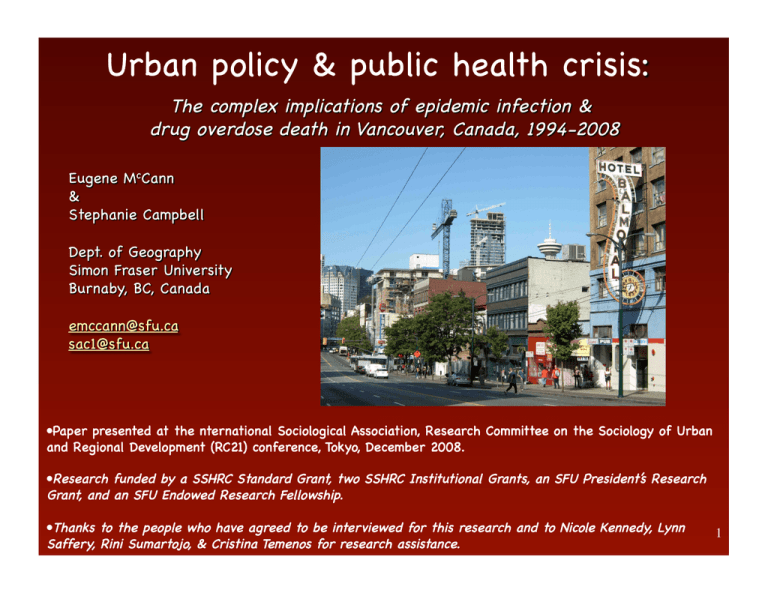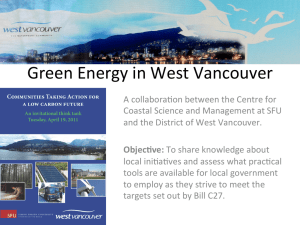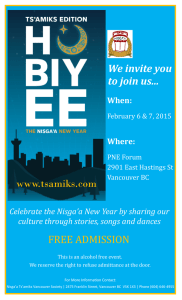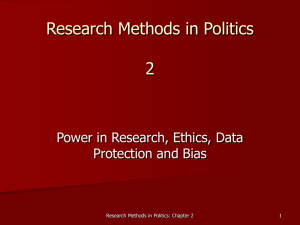Document 12731580
advertisement

• Paper presented at the nternational Sociological Association, Research Committee on the Sociology of Urban and Regional Development (RC21) conference, Tokyo, December 2008. • Research funded by a SSHRC Standard Grant, two SSHRC Institutional Grants, an SFU President’s Research Grant, and an SFU Endowed Research Fellowship. • Thanks to the people who have agreed to be interviewed for this research and to Nicole Kennedy, Lynn Saffery, Rini Sumartojo, & Cristina Temenos for research assistance. 1 Conceptual & Methodological starting points Relationality / Territoriality [W]hat is commonly referred to as ‘urban politics’ is typically quite heterogeneous and by no means referable to struggles within, or among, the agents structured by some set of social relations corresponding unambiguously to the urban (Cox, 2001: 756) Disease, Life & Death, and Urban Governance Rather than operating solely in between the often contradictory challenges of social cohesion and economic competitiveness, urban governance may soon have to be more centrally concerned with questions of widespread disease, life and death (Keil & Ali, 2007: 847) Purpose • General: A social history of the development of a new drug policy in Vancouver focusing on its ‘transfer’ from elsewhere and the political ‘making up’ (Ward, 2006: 70) of the policy in the wake of HIV & Hep C epidemics, & large numbers of drug overdose deaths. • Specific: To begin to conceptualize the ‘local’ politics of constructing the new drug policy and its complex implications for the city and drug users. 2 Outline a. "Introduction: the epidemic, the politics, and the policy " "From health emergency to Harm Reduction in an ‘addicted "city’ b. "What happened in between: " "A ‘dual mobilization’ of policy & politics c. "The complex implications of the epidemic: " "(1) The successes of Vancouver’s Harm Reduction approach " "(2) The limits to Harm Reduction? " " " " d. "Discussion 3 Health emergency: 1997 • 1997: 18% HIV incidence rate among IDUs • 1998: 191 Overdose deaths in Vancouver • 1992-2000: 1,200 documented overdose deaths in a neighbourhood of 16,000 people • Increased deinstitutionalization/homelessness • Severe shortage of clean needles 4 Political / policy response -- Search for solution beyond criminalization model. -- 2001: Vancouver institutes its ‘harm reduction’ policy. It is official city and provincial policy. It treats illicit drug use as primarily a public health, rather than a criminal issue. -- 2003: ‘Insite,’ N. America’s only legal supervised injection site for illicit drugs, opens under a temporary Federal ‘Section 56’ exemption to the Canada Health Act. -- Peer-reviewed medical studies credit Insite with reducing deaths & infections, encouraging IDUs to get counseling/treatment, & reducing public injection and related litter on the streets. 5 How it works: -Bring in your ‘street drugs’ -Register -Wait (usually) -Get a booth & sterile water, needle, etc. -Inject -Hang out in the ‘chill room’ (hopefully) -Get counseling (hopefully) -Leave 6 b. A ‘dual mobilization’ of policy & politics Policy mobilization (to import a new model of drug policy) • Late 1990s – early 2000s: An active search by local planners, nonprofits, and activists for an alternative approach to the predominant criminalization stance. • The resultant transfer of a ‘harm reduction’ policy model from Swiss and German cities. This model seeks to reduce harms of drug use by providing sterile needles, safe places to use, reduced health care costs, and improved public order through reductions in public use and drug-related litter on the streets. On this policy mobilization see: "McCann, E.J. 2008. Expertise, truth, & policy mobilities: Global "circuits of knowledge in the development of Vancouver, Canada’s ‘Four "Pillar’ drug strategy. Environment & Planning A, 40(4): 885-904. 7 b. A ‘dual mobilization’ of policy & politics Political mobilization (to build a political coalition bridging cleavages of class, culture, and the city’s geography in order to address the crisis and change drug policy) • Local ‘frontline’ health, non-profit, and government professionals and researchers • VANDU, an organized group of drug users based in the DTES • AIDS Vancouver, an organization based in the city’s west end gay community • From Grief to Action, parents of drug users in Vancouver’s wealthy west side • Provincial politicians, public health officers, and many national politicians • Local media (newspaper and radio journalists, and an independent documentary film-maker) 8 c. Implications: Successes of the Harm Reduction approach Drug-related deaths, Vancouver 1998: 191 2008: ~30 Reasons? - Hard to say as these rates often fluctuate but lower quality heroin, uneven supply, higher enrollment in methadone programs may be contributing. -But also Insite (medical services, counseling, and empowerment roles) and the empowerment of users through organizations like VANDU). 9 c. Implications: Successes of the Harm Reduction approach April 1st 2004 - March 31st 2006 - 7, 278 registered individuals (avg. 607/day) [currently: over 800] - 4, 084 referrals to medical services and counseling (40% to addiction counseling) [percentage has since increased] - 453 overdoses [now averaging 100 overdoses per day] - Zero overdose deaths - Full research findings on Insite’s impacts at: "http://www.communityinsite.ca/science.html Wood, E. et al. CMAJ 2004;171:731-734 10 c. Implications: Limits of the Harm Reduction approach Limits of political will • Underfunding for: "(a) enough supervised injection capacity "(b) detox and treatment beds "(c) housing • The continued threat to Insite from the national Conservative government (a slow ‘death by evaluation’?) • An Olympics-related clean-up of the streets with a bleak post-Olympics future? 11 c. Implications: Limits of the Harm Reduction approach Conceptual/political concerns: Harm Reduction as neoliberal governmentality? • The production of responsible, self-governing subjects (‘new’ drug users), fit to live in the neoliberal, entrepreneurial, ‘livable’, ‘sustainable’ Olympic city? SISs can be meaningfully understood to emerge from within an ongoing politics of socio-spatial order in the ‘new city’, and that their operations rely primarily on disciplinary technologies responsibilising the drug user as an agent of risk related to health. Further, we argue that rather than replacing existing punitive control of illicit drug use, these new and ostensibly more ‘progressive’ practices of governance coexist alongside more traditional forms of repression (i.e., law enforcement), and indeed can be seen to mask and allow them to continue. Fischer et al. 2004. Drug use, risk, & urban order: Examining supervised injection sites (SISs) as ‘governmentality.’ Intl. Jrnl. Drug Policy, 15: 357-365 12 Conclusion • Epidemics (urban or otherwise) are not just health issues, but objects of governance, of policy, of politics. • Urban epidemics offer opportunities for understanding the simultaneously local/territorial and global/relational aspects of urban policy-making and politics. • An urban epidemic, like a city, is “a constellation of processes rather than a thing … open and … internally multiple” (Massey, 2005: 141). Both are complex and contested and demand further study. 13





